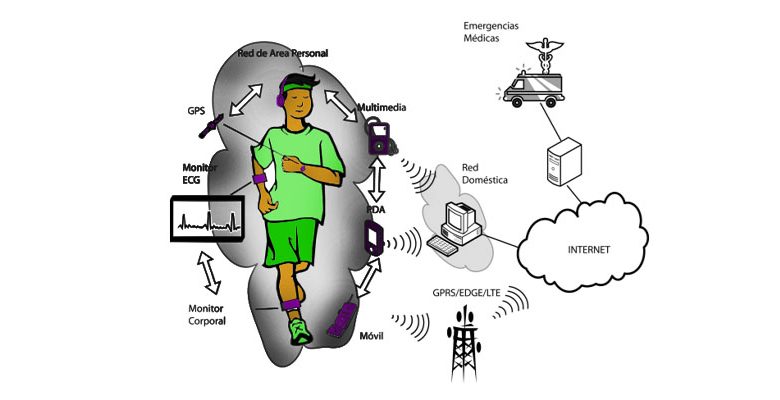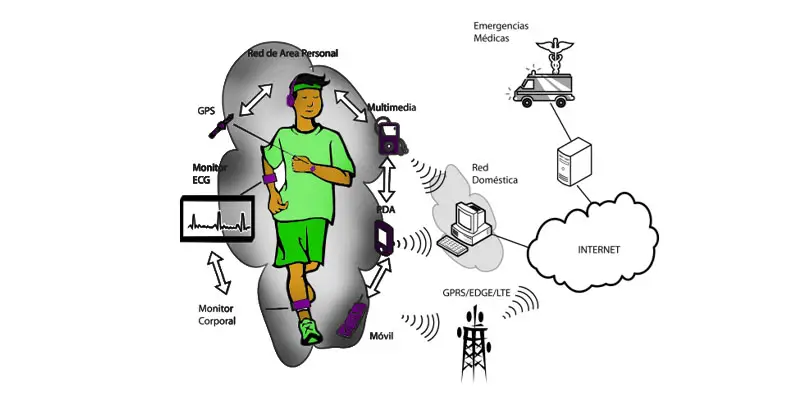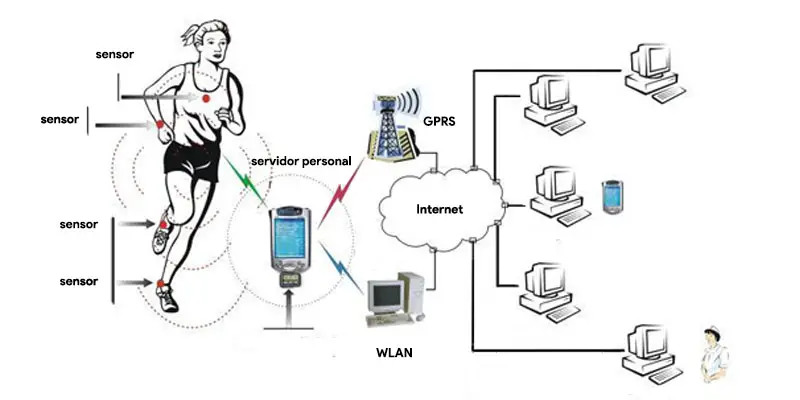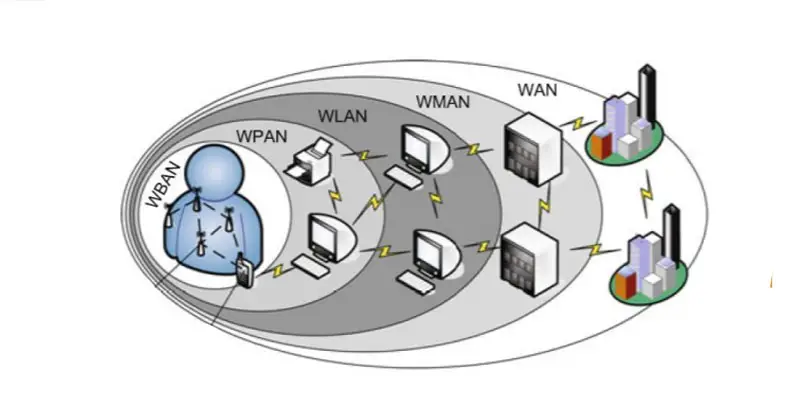Body Area Networks: what are they, types and what are these BANs used for?

Technology does not stop evolving and, although the concept that we are going to see today has been in use for some time, the truth is that it is a point to be developed, with a lot to offer and that we can grasp in a multitude of areas of our life: networks of bodily areas.
You are familiar with WLANs, right? Maybe also WMAN, but do you know what are WBAN ?Don't worry, this is the usual thing. These are not the main topic of conversation in the bakery and, in fact, their nascent development means that they are neither, nor in the contexts in which computing and technology are emerging.
Of course, if you are curious you should know that you have come to the right place because, in fact, we will be the ones to tell you what a body network is, what it is used for and how it is formed .
What is a Body Area Network and what is it used for in IT?
 Le body network , called BAN by its English name Body Area Network, is a type of network that the small, low-power devices that we use in our bodies use to communicate . Thus, we deduce that these are those who have the least reach .
Le body network , called BAN by its English name Body Area Network, is a type of network that the small, low-power devices that we use in our bodies use to communicate . Thus, we deduce that these are those who have the least reach .
The devices that use it are headphones, viewers, microphones, smart watches, smartphones, glasses, nanobots, telematic bracelets… BANs are also used by those that are implanted and used for medical purposes as hearing aids, valves or pacemakers.
By bringing together several of them, a system is formed which allows information to pass from one to another and also to platforms. - external forms which can also be viewed outside the system. Storage needs to be remote to keep devices small and light.
As you can imagine, this type of network is quite common. In fact, it is something that is still growing tentatively and still has a long way to go.
Although we can see it in different sectors. In addition to health, who is the main one and the one who could benefit the most, we take advantage in consumer electronics, in entertainment, in the work environment, in sport, in improving person-to-person or person-to-machine communication. and beyond.
For the moment, these use standards that we already know as WiFi or Bluetooth, but the ideal is that they can be interconnected with other types of networks such than WLANs, WPANs.
Components of a BAN Network What does it take to create one?
 As we say, the body surface network requires a system of elements. However, these vary in each case. The only essential element is the one able to manage the information that it receives from one of the others, that is, the one who acts as a central platform. We also see that there must be a standard of communication .
As we say, the body surface network requires a system of elements. However, these vary in each case. The only essential element is the one able to manage the information that it receives from one of the others, that is, the one who acts as a central platform. We also see that there must be a standard of communication .
Depending on the type of features to be enjoyed, obviously the devices and their possibilities will be diversified , but it's already something that goes hand in hand, as they say, with what we want to achieve.
Let's take an example: a runner wears a smart watch that measures their heart rate and other biometric parameters. When it considers it, it tells you where the nearest source is. This will require a biometric sensor, a GPS, a database that indicates which parameters are "normal", a query action for that ...
On the other hand, we can see the case of bracelets worn by people released from prison. They beep when the user exceeds a distance X of a point and a warning is given.
The bracelet must be geolocated, a proximity sensor, an element capable of sending a signal, a device which receives the alert of perimeter exceeded, an audible element which is activated when said signal is sent or when it is close to passing the stipulated distance, etc.
"UPDATE ✅ Do you need to know the definition of a BAN network and you don't know what it is? ⭐ ENTER HERE ⭐ and find out everything you need to know about it EASY and QUICK ✅ »
Indeed, some systems are totally different from others , and so we could continue to dismember each of them. What we want you to understand is that the elements that make up bodily networks differ as much as their purposes.
So, he we stay :
- An element or platform that manages information.
- A communication standard.
- Items or devices with the capabilities we want to achieve.
What types of computer networks are there?
 Finally, we would like you to get an idea of what What do BANs mean when compared to other types of existing networks:
Finally, we would like you to get an idea of what What do BANs mean when compared to other types of existing networks:
- Network WAN or extended networks . Its coverage is practically worldwide, over thousands of kilometers. With a few, we provide a connection to the entire planet. They use Cellullar Digital Packet Data technology, which enables data transmission by mobile phone.
The protocol par excellence for this type of connection is the famous WAP, a standard that does not limit devices, being indifferent aspects such as, for example, their operating systems. We also use satellite communication to access areas where communication is most difficult by other means.
- Networks MAN or metropolitan networks . Their range is several hundred kilometers, which means that they are the ones chosen by the operators to cover the coverage areas of their Internet connection services.
They work with the standard WiMAX , which has a transmission speed of 75 Mpbs with frequencies up to 66 GHz, which means that an efficient multipoint architecture can be designed.
- Networks LAN or local networks . Lower in rank, they are of great interest as the tapes they use are unlicensed meaning anyone can use them assuming minimal investment to do so.
They are what ordinary users use to connect to the network , both wired and wireless (in this case they would be WLAN). We do it in us connecting to a coverage point, keeping us at a distance from it while it interconnects with others (including servers, antennas and other devices) distributed throughout the coverage area.
- Networks PAN or personal networks . Still in development like those we are dealing with today, PAN networks were born so that the user and the network can meet and be part of the same system, seeking the integration of services close to him and therefore automation, to the possible and the environment.
To do this, the devices that the user uses can communicate with each other (laptop, smartphone, digital camera, PDA, surveillance systems.
We would talk about a system that gravitates about 10 meters around the user and that works without her body needing to be part of the communication.
- BAN networks or personal networks . They are those which cover the least surface or space, that is to say those which operate at a shorter distance . We have already seen that the system is composed of devices that go on the body of the user , so the range of action is minimal , a few meters at most (except for sending information, which would be done by combining with another type of network) and considering always le body of the person as an element de transmission of information.
Regarding the types of local networks, we have WBAN and WLAN . The difference between the two is that the latter would be wireless , hence its name, “Wireless Body Area Network”.
Therefore, we would use the wiring to be functional, as happens with local networks, when we connect our computer to the router through an Ethernet cable. The other, as they say, would work without cables, using a wireless standard. Obviously, this last option is the one that makes sense in the systems that reach the body.
Finally, it should be noted that one can also consider the existence of other types of networks, although these would be more specific such as VLANs, CANs and others. We can deal with them all in another article in which we would see, one by one and in detail, all the existing ones.
If you have any questions, please leave them in the comments, we will get back to you as soon as possible, and it will be a great help for more community members as well. Thank you!




